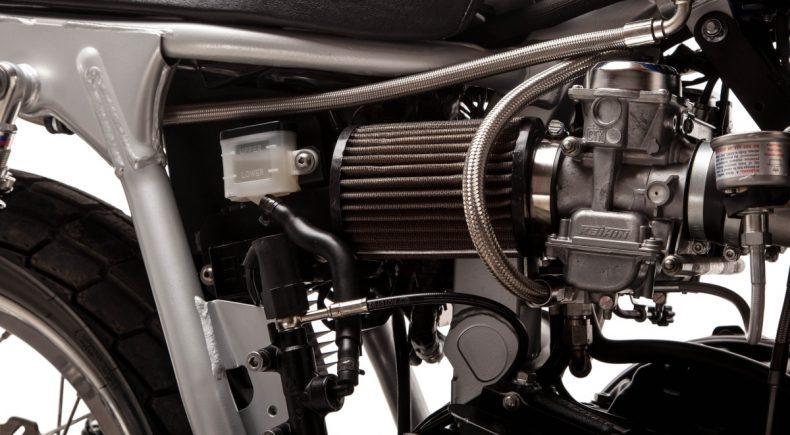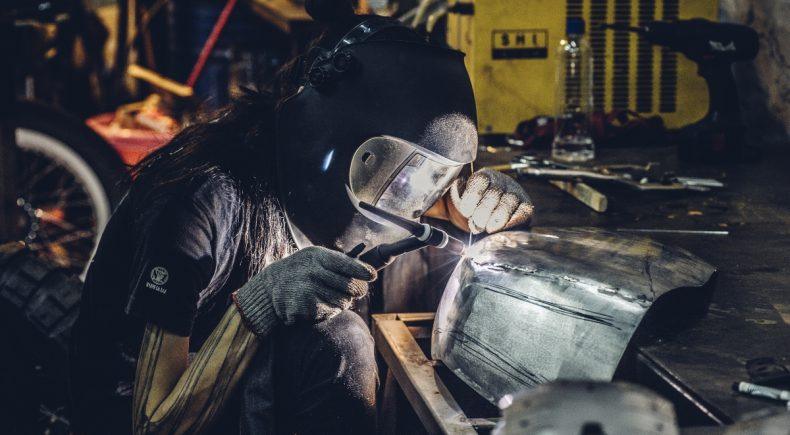Among retro motorcycle enthusiasts, there has been a long-standing and divisive debate that preceded the air-cooled versus liquid-cooled debate. The topic of so much emotional rhetoric and scientific base-building was Triumph’s decision to transition from carbureted motorcycles to fuel injected (EFI) motorcycles. But unless you’ve been around long enough to see the same transition in other parts of the scene, you may not know what exactly all the fuss is about.
The thrust behind most of the debate is between authenticity and practicality, with the pro-carbureted side of the debate claiming that the carbureted bikes stay true to their heritage and the pro-EFI camp stating that an air-cooled EFI motorcycle is the best of both worlds. Why is that, though? And what exactly is the difference?
The components under fire are the components managing fuel delivery into the cylinders. The main difference between the two is that carburetors are mechanical and fuel injection utilizes a digital platform. Carburetors have jets and floats that dictate how much fuel goes into the cylinders when you pull on the throttle. EFI systems lean on O2 sensors and computers to figure out how much fuel should go into each cylinder when you pull on the throttle. What this implies is that carburetors can be worked on by anyone in their own garage, and EFI bikes require pricey electronic setups in order to be adjusted.

Actually carburetors (with air filter covers).
Since they’re purely mechanical (at least, those on the air-cooled Triumphs are), you can work on carburetors by hand with basic tools. This entails two major things. The first is that you can work on your engine yourself if it’s having issues stemming from fuel delivery. The second is that you can tune your engine yourself with basic tools to maximize its performance.
Carbureted bikes require you to be more involved and in tune with the bike. If it isn’t idling properly, all you have to do is adjust the choke knob and get it up to the right RPM. If you want more horsepower, pop in a new $18 set of jets and adjust their settings until you’ve found the sweet spot. Carburetors also have a rich sense of history. Every time you pull your carbs off to clean them or tweak the jets in pursuit of a little more oomph, you’re following in the steps of all the legendary motorcyclists of yesteryear who did they exact same thing. The only thing about tuning your carbureted engine’s performance is that each cylinder is controlled by a different carburetor. And unless you’re a seasoned carb tuning professional, your tune won’t be perfect. But it’ll be pretty damn close, don’t get me wrong, and that’s probably as close as it ever really needs to be, if we’re being honest.
The downside of carbureted bikes is that the fuel delivery settings are static. Simply put, a carburetor uses jets to inject fuel into the cylinder. Depending on the jets’ settings, more or less fuel is pulled into the cylinder as air is drawn into the cylinder. The catch here is that the the amount of fuel being injected into the cylinder depends on the throttle angle, and not the amount of air being pulled into the cylinder. If you go up in altitude, for example, you may run into issues since the settings that worked great at sea-level may not work when there is significantly less air in the surrounding environment. That issue can be resolved if you have somewhere to pull over and a toolkit on you to readjust your carbs, but then you’ll have to reset everything once you go back down to sea-level.
EFI bikes are a completely different story. EFI bikes have an electronic engine control unit more commonly known as an ECU that manages the air-to-fuel ratio in the cylinders for you dependant upon multiple factors. The ECU comes stock with a fuel table that’s basically a spreadsheet dictating how much fuel should be injected into each cylinder depending on the engine RPMs, what gear you’re in, and the throttle angle to maintain peak efficiency while also keeping emissions low. Which sounds fairly similar to carburetors, right? But here’s where the O2 sensors come into play. The O2 sensors monitor the O2 levels in the exhaust gases, and if the bike is running too rich or too lean depending on emissions regulations, the O2 sensors override the fuel table and will either add or reduce the amount of fuel being injected in order to maintain a clean burn. EFI bikes rarely have altitude issues because they also have pressure sensors which help them maintain their a/f ratios depending on how much air they’re pulling into the cylinders. They also have temperature sensors which help you maintain engine efficiency and keep your bike from overheating as well.
EFI bikes are then a double-edged sword. They practically run themselves and do a pretty darn good job at it no matter what kind of situation you find yourself in regarding temperature and elevation (unreasonable extremes notwithstanding). However, if you want to boost your performance, it isn’t as easy as it is on a carbureted bike. If you want to increase your horsepower, all that stuff overriding your fuel map and choking your air intakes has to go: you have to remove all your emissions components including the air box and air injection system (if it’s legal where you live) and then get a custom fuel map made for your bike. Is any of this hard to do? Not at all. Does it mean you can tune your engine in your garage and play with it to get it exactly where you want it? Not exactly. You certainly can buy a Dynojet Power Commander V and download the software and a fuel map and tweak the map to your preferences, but to get the best tune you’ll have to take it to a specialist who will hook it up to a Dynotuner. Once the map is made for your bike though, you’ll have the confidence that literally every drop of power has been scientifically squeezed out of your engine and that you are getting the absolute most out of it. The only drawback? You didn’t do it yourself.
If you’re worried about looks, though, you’re pretty safe either way with a Triumph modern classic like the Bonneville, Thruxton, and Scrambler, or even the cruisers like the America, Speedmaster, and Thunderbird. The EFI models have components that look like carburetors — they’re even attached to the air filters for effect — but that are actually throttle body housings. From the outside, you can’t even tell they aren’t carburetors. If you opened it up, though, you would immediately see the difference by what’s hidden inside the housing.

Not actually carburetors. Can you tell the difference?
In the end, carbureted bikes and EFI bikes are both great, but for very different reasons. They’re also meant for very different riders who are looking to have very different experiences owning and working on their motorcycle. Riders who want to work on every part of their motorcycle by hand and be able to tune it themselves should go for carbureted models. Riders who just want to be able to ride and are fine with a computer figuring out what’s best for the current situation should go with an EFI bike. Riders who want to embrace their heritage and place themselves in the boots of those who came before should go with carbureted models. Riders who want to tune their bikes to the absolute max should go with EFI models. But who’s to say a rider from one camp can’t in good conscience hop the fence? There’s a place and time for both models, because as always, whatever feels best to you is the best.




Leave a comment
All comments are moderated before being published.
This site is protected by hCaptcha and the hCaptcha Privacy Policy and Terms of Service apply.